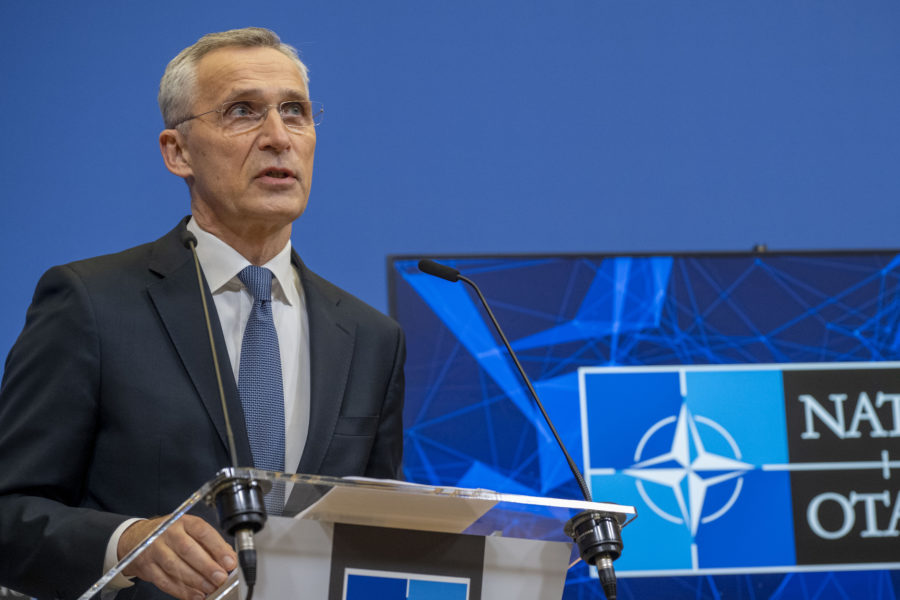NATO has for the first time activated about one-third of its response force, including some 7,000 U.S. troops, while Defense Secretary Lloyd J. Austin III called on allies to further strengthen the alliance against potential Russian aggression following its invasion of Ukraine.
“President Putin’s decision to pursue his aggression against Ukraine is a terrible strategic mistake for which Russia will pay a severe price for years to come,” said NATO Secretary-General Jens Stoltenberg after a virtual meeting of NATO heads of state Feb. 25.
Stoltenberg said NATO activated its defense plans Feb. 24, deploying elements of the NATO response force (NRF) on land, sea, and in the air. President Joe Biden’s public statement announcing the deployment of an additional 7,000 U.S. troops to Germany supports the NATO NRF effort.
“We stand ready, if called upon by NATO, to support the NRF in the defense of the alliance,” Pentagon spokesman John F. Kirby said in a Feb. 25 briefing. “A good chunk of the 7,000…will be earmarked for NATO contributions. Again, if it’s deemed that they are needed.”
Kirby emphasized that the American troops are meant to defend the NATO alliance, not fight Russia.
“The President has been very clear that U.S. troops will not be fighting in Ukraine,” he said.
Austin’s Feb. 24 decision was accompanied by a series of calls with 15 NATO allies and European counterparts about the Russian war against Ukraine.
The conversations included individual calls with his counterparts in Canada and Turkey; a joint call with defense ministers from France, Germany, Italy, and the United Kingdom; and, for the first time, a secure teleconference with his counterparts from the Bucharest Nine (B-9) eastern flank countries, which include Bulgaria, the Czech Republic, Estonia, Hungary, Latvia, Lithuania, Poland, Romania, and Slovakia.
In the calls, Austin noted the 15,000 additional U.S. troops sent to Europe in recent weeks and months, and called on his counterparts to consider additional contribution to strengthen NATO and bolster Ukraine’s defenses.
In addition to thousands of U.S., Canadian, and European troops on the eastern flank of the alliance, NATO maintains 100 jets on high alert at 30 operating locations and 120 ships at sea, including three carrier strike groups.
“We must stand ready to do more,” Stoltenberg said. “Even if it means we have to pay a price, because we are in this for the long haul.”
Stoltenberg said only one-third of the NRF, which totals some 40,000 troops, had been activated, adding the NRF has tripled since Russia’s invasion of Crimea in 2014.
Russia now poses a new threat to European security, he said.
“The Kremlin’s objectives are not limited to Ukraine,” Stoltenberg said, referring to two draft treaties presented by Putin in December calling for a withdrawal of all NATO forces from member states that joined after 1997 as well as blocking any future NATO membership, to include Ukraine and Georgia.
NATO and the United States have rejected Russia’s demands, which Putin said were based on Russian security concerns. In January, NATO met with Russia to discuss its concerns, and offered further negotiations on areas including arms control, missile-defense, and military exercises.
Given Russia’s invasion of Ukraine, Stoltenberg said the alliance had to take Putin’s threat of non-compliance seriously and shore up the eastern flank of the alliance, which borders Russia and Belarus, where tens of thousands of Russian troops are operating.
“If we don’t meet the demands, there will be what they call ‘military technical consequences,’” Stoltenberg said. “So, we have to take this seriously. And that’s exactly why we are now deploying the NATO response force for the first time in a collective defense.”
Stoltenberg said some of the NRF air component was already active, while some land troops would be ready in “a few days.”
The Secretary-General said the alliance continued to show unity in its support for NATO partner Ukraine.
“NATO allies have and continue to provide support … [and] different types of equipment to Ukraine,” he said. “Allies announced, and also informed, other allies about the type of weapons, the type of support, and some of that also includes air defense systems.”
In a statement issued by NATO Feb. 25, the alliance condemned Russia’s full-scale invasion of Ukraine, enabled by Belarus, and called on Russia to “immediately cease its military assault, to withdraw all its forces from Ukraine, and to turn back from the path of aggression it has chosen.”
The statement called the NRF movements “preventive, proportionate, and non-escalatory.”
Responding to reports that Ukraine had agreed to begin peace talks with Russia in Minsk, Stoltenberg said Moscow had an easy path to peace:
“If they want peace, it’s just stop … attack[ing] Ukraine.”
